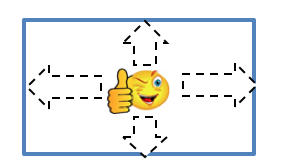The four Motivation Styles make up a ‘balanced team’, and are useful for recruitment and appointing new team members. All people tend to exhibit aspects of all four Styles, however it is common for one or two styles to be more dominant in each person. It is inevitable that a team or board will consist of individuals with different dominant Motivation Styles. This means that competition is inherently built in to every team. When team members understand the four Styles it will promote collaboration and reduce competition and conflict between different Styles. It will also assist in resolving competition and conflict when this does arise. They will be able to recognise their differing styles and how these can complement one another. Various Motivation Styles can act as the ‘oil’ between more contrasting Styles to promote understanding and collaboration. This is pointed out in the profiles.
The profile identifies four Motivation Styles in terms of ‘Boundaries’, where Boundaries stand for defined expectations and recognised processes for achieving objectives. .
- Boundary Keepers prefer to know what the boundaries are i.e. what is expected of them and how they will know they are accomplishing tasks correctly within set boundaries.
- Boundary Pushers are motivated by being engaged in tasks that have personal meaning for them and will ‘push’ themselves to the boundaries of what is possible in achieving a task if it really interests them.
- Boundary Fillers are motivated by harmonious relationships in a team, where the boundaries are filled with relational collaboration and peace.
- Boundary Developers question existing boundaries and are motivated by exploring how and where the boundaries can be developed and altered in innovative ways.
More detailed descriptions of each Motivation Style are below.
1. Boundary Keepers

- Boundary Keepers like to know what is expected of them and what the ‘rules’ and correct procedures i.e. what the boundaries are and how to stay within them. When they know what boundaries they are expected to work within they rarely disappoint.
- They prefer to know what others expect of them and what a completed task should look like.
- They are interested in completing any tasks in the correct way, or being told exactly how it should be done, so they have the confidence they will complete it as expected.
- Accurate time-keeping can be one aspect of their desire to work within boundaries. This not the typical profile of a Boundary Developing entrepreneur and may cause frustration.
- Recognition in the form of tangible appreciation or rewards can be important to them and salary, or bonuses, may be one way they measure this.
- In a team context they will be de-motivated and frustrated if boundaries are vague or unclear, or by unpredictability or failure of others to honour commitments.
- The potential for competition and conflict will arise mainly from working with Boundary Developers in a team. This is because they are motivated by the opposite of what motivates Boundary Keepers and move on with new ideas and projects when other projects have not been completed, or new ones not adequately costed or processes identified.
- Boundary Developers may interpret Boundary Keepers concerns and questions about details as impeding and obstructing the progress they are impatient to make.
- A Boundary Keeper may be vital in translating the random thinking of the Boundary Developing entrepreneur into a logical format that others can understand and follow more easily
- They may also find tensions with strong Boundary Fillers who are motivated by having time for relational and social interaction and find strict time constraints or rigid agendas do not allow time for this.
- Boundary Fillers may find Boundary Keepers are too focused on completing tasks to make sufficient time for relational interaction or take on board how other team members are feeling emotionally about themselves and others involved in the enterprise.
2. Boundary Pushers

- Boundary Pushers are motivated by being able to complete work to their own satisfaction and not be rushed or forced to work to deadlines if it will compromise the quality of their work.
- They like to ‘push’ the quality of their work to the best of their capacity or limits of their Boundaries if they are personally interested in it or if other people show specific appreciation for the quality of their work and extra effort.
- Boundary Pushers invest extra time and effort in work they are personally interested in, but are less motivated to invest in work that does not interest them.
- A reward for them is being able to take on a harder challenge rather than remain with work they have mastered already.
- Competition and conflict could arise between them and strong Boundary Keepers who are comfortable with deadlines and look for more rigid ‘boundaries’ for their work.
- Conflict can also arise with strong Boundary Developers who are motivated to keep things moving forward and often rush work to do so.
3. Boundary Developers

- Boundary Developers are motivated by being able to be innovative rather than be confined to previously established ‘boundaries’ for tasks or projects.
- They are motivated by being able to keep moving forward rather than ‘mark time’.
- This means they are more likely to look for alternative approaches to creatively shape new boundaries.
- They prefer to be given options rather than be confined to a set way of doing tasks.
- These characteristics mean that innovators, entrepreneurs and intra-preneurs are typically strong Bound Developers.
- They question the reasons why certain boundaries should be adhered to and may challenge accepted rules or approaches to doing things, i.e. existing boundaries, and appear to be ‘disruptive’ to other team members.
- They are motivated by the freedom to creatively develop new boundaries due to seeing alternatives to what they had been expected to do in a task.
- The Boundary Developer’s willingness to take charge in situations and to make decisions based on their intuition, instinct and ‘gut feeling’ are typical of innovators and entrepreneurs.
- The preference for active learning ‘on the job’ rather than classroom-based learning means that they will develop best in situations where they can be ‘hands on’ and take the ‘protected risks’ that train them to become confident in their own instincts.
- Boundaries are not seen by them as something to be restricted by. Other people’s rules may serve more as guidelines for them as they explore beyond existing boundaries.
- May have a tendency to find reasons for doing things they are not expected to do.
- They are more likely to think randomly than sequentially in dealing with information and to get ideas ‘out of the air’. This can make it harder for people who think logically to follow their random line of thought, especially if they see possibilities in situations which others do not see.
- They may need others to ‘translate’ their random thinking into a more sequential format that others in a team can understand and follow.
- Their tendency to challenge and take risks can cause others in the team who recognise and look for boundaries to be uncomfortable or even resistant.
- This may lead to competition and even conflict with other Motivation Styles in a team.
- It is important to recognise when other Motivation Styles are struggling with what inspires and motivates the Boundary Developer. It may actually de-motivate them.
- A ‘balanced team’ should include Boundary Keepers, Fillers and Pushers to complement the Boundary Developers, but Boundary Developers are often so keen to move ahead that they can be slow to appreciate the need to build up a well-balanced team.
4. Boundary Fillers

- Boundary Fillers are motivated when their work environment is relationally ‘filled’ by peaceful and harmonious relationships among team members.
- They contribute to relational harmony in a diverse team.
- Reward for them is enjoying relational interaction and bringing harmony and peace to a team.
- They like to have time for relational and social interaction and are de-motivated when they are forced to work within strict time constraints or rigid agendas that do not allow time for this.
- Boundary Fillers may find entrepreneurs too focused on completing tasks to make sufficient time for relational interaction or take on board how other team members are feeling emotionally about themselves and others involved in the enterprise.
- They may find Boundary Keepers too preoccupied with keeping to rules and procedures and ignoring relational implications
- They will usually comply with what is expected of them for the sake of relational peace, but may resent the goal-orientated pressure internally.
- They can play a valuable role in recognising when competition is developing between team members and preventing relational conflicts or resolving them.
